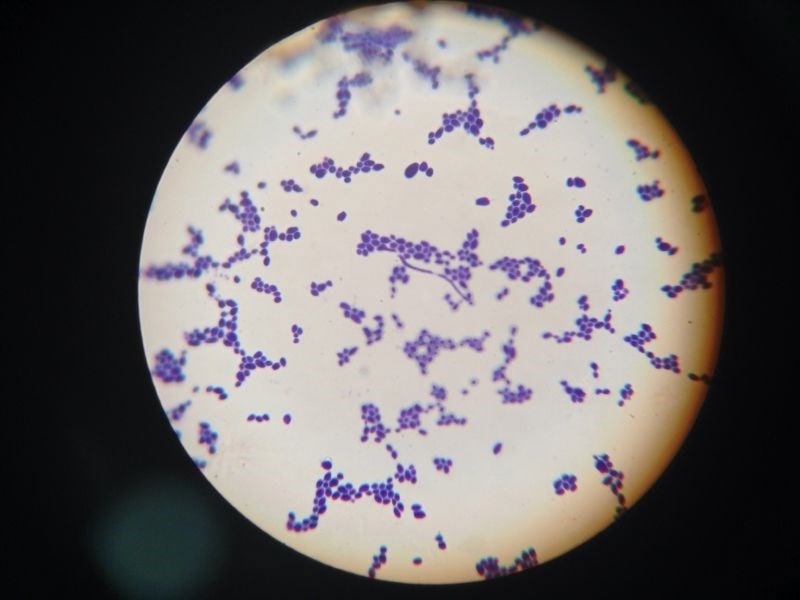Which Probiotics are Best for Candida?
A common question regarding probiotics is if they can help in cases of Candida albicans yeast overgrowth, commonly known as Candidiasis or fungal dysbiosis. (Read more about dysbiosis over on our sister site, the Probiotics Learning Lab here: What is Dysbiosis?) We'd say that it's very important that all Candida diet and supplement protocols are undertaken with the support and guidance of a suitably qualified therapist. Many symptoms of Candida overgrowth are similar to those relating to other health conditions, so it is also essential for individuals to first consult with their doctor to rule out other medical causes for their symptoms.
- How do probiotics help with Candida?
- Which are the best probiotics for Candida?
- Is there a recommended probiotic supplement protocol for Candidiasis?
- Other helpful probiotics for Candida symptoms
- Are any probiotics NOT recommended for Candida?
- Candida in-depth
- What is the difference between Candida and SIFO?
- Key takeaways
How do probiotics help with Candida?
Probiotics can help with Candida in various ways, depending on the individual properties of that specific probiotic strain. Some strains can help to inhibit the growth of Candida, others can help to prevent Candida from colonising the gastrointestinal tract, whilst others can produce anti-fungal substances effective against Candida. The best probiotics for Candida are found in Optibac Probiotics Saccharomyces boulardii, Every Day EXTRA and Every Day MAX which we will discuss in detail throughout this article. Other helpful probiotics include Bifido & Fibre and For Women, read on to find out more about the studies behind the strains in these products.

Which are the best probiotics for Candida?
As Candida yeasts are natural residents of the human body, doctors are often reluctant to offer allopathic support unless the condition manifests as obvious fungal infections such as thrush. Even then, their arsenal is limited to anti-fungal medicines, though it's been encouraging to note that some doctors are now suggesting that their patients consider natural supplements including probiotics.
It is very important to select the right strain of probiotic for the right condition, however, and so it’s best to use those products containing species and strains that have been well-researched and shown to help discourage and address Candida overgrowth. To find out more about probiotic strains and what exactly a 'strain' is, see this article What are Probiotics?, over in our sister site, the Probiotics Learning Lab.
The best probiotics for Candida include:
Saccharomyces boulardii
Saccharomyces boulardii is itself a yeast, but one with probiotic potential which has displayed anti-Candida properties in relevant research studies. S. boulardii has been shown to inhibit populations of Candida and deter them from establishing in the intestines1, and it's also suggested that S. boulardii may help to reduce the risk of Candida yeasts translocating from the digestive tract2. It's thought that these effects occur because S. boulardii produces caprylic acid, an antifungal substance which is effective against Candida yeasts3. S. boulardii has also been shown to reduce the potential for Candida infestation and inflammation in inflammatory bowel disease4.
Find Saccharomyces boulardii in Optibac Probiotics Saccharomyces Boulardii.
Lactobacillus acidophilus NCFM®
Beneficial bacteria can also help to displace Candida populations; in particular, one of the most well-researched strains of Lactobacilli, Lactobacillus acidophilus NCFM®, has been shown in studies to stimulate the production of antibodies to C. albicans antigens5. A review of studies on Lactobacillus probiotics against candida showed several species to have the potential action to inhibit the growth and quantity of colony-forming units of Candida species in vitro studies11.
Find L. acidophilus NCFM® in Optibac Probiotics Every Day EXTRA and Every Day MAX.
In addition to the above-mentioned strains that are known to help clear C. albicans from the GI tract, other strains of probiotics may also be useful to reduce some of the common symptoms of Candidiasis. For example, vaginal thrush can be ameliorated using the well-researched strains: Lactobacillus rhamnosus GR-1® and Lactobacillus reuteri RC-14®. Constipation, another common symptom, can be managed using Bifidobacterium lactis BB-12®. These strains are discussed in more detail below, in the section headed: ‘Other helpful probiotics for Candida symptoms’.

Is there a recommended probiotic supplement protocol for Candidiasis?
The following probiotic support has been recommended for those suffering with Candidiasis:
- Saccharomyces Boulardii:
Start with 1 capsule twice a day (morning and evening) for the first week.
Increase to 2 capsules twice daily for the second week.
By the third week increase to 2 capsules three times daily.
- A high-quality daily probiotic, such as Every Day EXTRA
1-2 capsules daily with breakfast
The required dosage for Saccharomyces Boulardii may vary from person to person, dependent on tolerance, and the level of Candida overgrowth in the gut. The best thing to do is to start off with a low dose and gradually increase. This helps to reduce the possibility of a 'die-off' reaction (for more information about 'die-off' reactions see the specific section at the bottom of this article).
You may find that sufferers don't need to reach the maximum dose of 6 capsules a day, and that 3-4 work fine to reduce symptoms. It is advised that patients stay on this dose for a number of weeks/ months until they feel the Candida has sufficiently left the system, or until the appropriate tests have confirmed this. Just to note – it is recommended that S. Boulardii is taken away from other anti-fungals (2 hours apart should be sufficient).
NB: Please recommend that clients should check with their doctor before using this supplement during pregnancy or whilst breastfeeding.
S. boulardii is a transient probiotic, meaning it does not take up residence within the gut, so a high-quality daily probiotic containing well researched strains such as Lactobacillus acidophilus NCFM® is recommended to take alongside it. In this way, at the same time that the S. boulardii is helping to eradicate the pathogenic yeast, the friendly bacteria in a high-quality daily probiotic can come in and repopulate the areas where the Candida once inhabited, and help to restore the balance of intestinal flora. This will hopefully reduce the risk of Candida overgrowth re-occurring and will re-enforce the mucosal lining of the gut – a vital part of the immune defences.
Health professionals can read more about the research which supports this strain in its entry on the Probiotics Database: Saccharomyces boulardii

Other helpful probiotics for Candida symptoms
Alongside treatment to eradicate the Candida yeast from the intestines, it may also be necessary to manage certain symptoms of the yeast overgrowth. As constipation can sometimes be an issue for sufferers, it can be helpful to start off the programme by trying to improve regularity in patients, particularly as S. boulardii can sometimes cause constipation at high doses.
For this, a combination of Bifidobacterium lactis BB-12® and Fructooligosaccharides (FOS) might be advisable. B. lactis BB-12® has recently been the subject of one of the world’s largest clinical trials on probioticsand has been found to promote regular bowel movements.
B. lactis BB-12® and FOS are found in Optibac Probiotics Bifido & Fibre.
Vaginal thrush can be another unpleasant and persistent manifestation of Candida infection for many women. Two strains of probiotics have over 30 years of scientific evidence to support their use for this condition – Lactobacillus rhamnosus GR-1® and Lactobacillus reuteri RC-14®.
These two strains are different to other probiotics in that they have been shown to colonise in the vaginal tract rather than the intestines. They have been clinically trialled by over 2,500 women who found the combination to be helpful in managing the symptoms of thrush as well as helping to discourage future infections.
Lactobacillus rhamnosus GR-1® and Lactobacillus reuteri RC-14® are found in Optibac Probiotics For Women.
To find out more about probiotics for thrush, please take a look at our article Which probiotics help with thrush?
Are any probiotics NOT recommended for Candida?
In general, there aren’t any probiotics that are contraindicated in Candida overgrowth; in fact, most probiotic bacteria offer some degree of anti-Candida potential through competitive inhibition/competitive exclusion (glossary definition, in the Probiotics Learning Lab: competitive exclusion) and by lowering the pH in the intestines; like most pathogens, this troublesome yeast prefers an alkaline environment.
There is however some debate over whether an anti-Candida protocol should include prebiotics, in the form of fructo-oligosaccharides (FOS) or inulin. One opinion is that prebiotics can ‘feed’ the Candida, and potentially worsen the dysbiosis. However, others believe that the positive effects of taking prebiotics from a high-quality source, such as encouraging the growth of ‘friendly’ bacteria in the gut, and increasing short-chain-fatty-acid (SCFA) production outweigh any potential negatives. If you are interested in finding out more about the debate you can read our blog over on the Probiotics Learning Lab, 'Does FOS feed bad bacteria?'
Candida in-depth
How does Candida become a health issue?
The Candida genus of yeasts is very large and includes many different species, although C. albicans is the most common culprit behind human fungal infections. Whilst C. albicans is the most common species of Candida to proliferate and cause health issues, others, such as C. glabrata and C. auris are increasing in prevalence. Candida is a natural resident in our intestinal tract, and normally our own defence mechanisms keep it in check; however, stress, illness, medications such as antibiotics and a high intake of sugary foods can create conditions favourable for the yeast to proliferate12. (Candida is a mould that feeds on other moulds). Even our external environment is important in the fight against Candida. Reducing the mould count in our homes, schools and offices limits our exposure to Candida and other microbes in the air, and therefore reduces the burden put on our immune system.
Once it has taken hold, Candida can be a challenge to overcome. Conventional treatments include anti-fungal medicines such as C**********. Whilst these drugs can initially help symptoms, Candida has the ability to retreat deep into body tissues when something threatens its survival. It can then lie dormant in these tissues until conditions for its survival improve. This is why it can sometimes take a combination of prescription (or natural) anti-fungals, coupled with appropriate dietary interventions, nutritional supplements, and effective probiotics to successfully eradicate it. Preventing the yeast from ‘burrowing’ into tissues and lying dormant is also one reason why some therapists take a measured approach when it comes to a patient's diet. Choosing not to eliminate all food sources for the candida at once, may prevent the yeast from ‘hiding’ and lying dormant.

On the whole, however, anti-Candida diets typically exclude processed, high-sugar foods, some fruits, and 'yeasty' foods and drinks like bread and alcohol which are all thought to promote the growth of this pathogen. Foods to which the patient are intolerant to, are also excluded. A gut-healing, immune health -supporting diet is desirable, along with foods that can help to naturally suppress Candida and promote the growth of beneficial bacteria. Coconut oil14 contains caprylic acid so can be a useful addition, as can olive oil, garlic13, onions and ginger for their anti-fungal and prebiotic potential.
What are the symptoms of Candida in the gut?
Symptoms of this yeast overgrowth can manifest in such a wide variety of ways that it can sometimes be as tricky to identify as it can be to address. In the first instance, any undiagnosed symptoms should always be discussed with a doctor, so that any appropriate clinical tests can be conducted, and more serious conditions ruled out.
Candida overgrowth in the gut can be associated with a history of high sugar consumption (even from fruit), severe stress or taking antibiotic/steroid/birth control medication. Anything that upsets the delicate balance of beneficial vs pathogenic microbes in the gut microbiome can be a factor.
Symptoms can include diarrhoea/constipation, bloating, belching, rectal itching, a white coating to the tongue, food intolerances, and a propensity towards stomach upsets. These ‘local’ symptoms can be uncomfortable enough, however, another possible side effect of Candida overgrowth is intestinal permeability (or 'leaky gut'). As the Candida yeast burrows into and compromises the delicate intestinal mucosa, Candida can eventually leach through into the bloodstream. Once it has become systemic, it can affect multiple body organs and other areas beyond the digestive system.
How do you know if you have systemic Candidiasis?
Fungal overgrowth that is outside of the gut environment can, in some ways, be easier to detect and identify. A good example of this is thrush (caused by Candida) which has give-away signs such as a thick discharge in the case of vaginal thrush, and a white coating to the tongue and mouth in the case of oral thrush. Other fungal infections such as athlete’s foot also have obvious signs to look out for. Infections such as these can be linked to systemic Candidiasis, or they can just be stand-alone, localised infections. Having thrush or athletes foot certainly doesn’t mean that you have systemic Candida, but having systemic Candida does raise the chance of developing localised yeast infections.
So, a propensity towards yeast infections at different body sites can be one possible symptom of Candidiasis. However, due to the many toxins that Candida produces, there are a whole raft of other possible symptoms that can occur. In fact, many health conditions are thought to have their basis in Candida overgrowth, including mental health disorders6 such as anxiety, confusion (or ‘brain fog’), chronic fatigue syndrome7, acne/eczema, headaches, skin rashes, allergic symptoms, joint pain15 and many other chronic health complaints.
The mycotoxins that the yeasts excrete can even cross the blood-brain barrier, which is how the mental symptoms such as confusion (often described as ‘foggy brain’) and anxiety can develop.
Do probiotics help support Candida?
Probiotics can help with Candida in a number of different ways.
- Competitive Inhibition – the term ‘competitive inhibition’ just means that probiotic bacteria compete for space and nutrients with pathogenic microbes in the gut. By taking up the space on the epithelial lining, probiotics prevent pathogens from adhering to our gut cells and damaging them. They also compete for nutrients, and generally make it harder for pathogens, including Candida, to flourish. The same principle can be seen in the vaginal tract. Using specific strains of probiotics that are known to colonise the vagina, results in less space and fewer nutrients being available to pathogens including Candida albicans, which cause vaginal thrush.
- Heal the gut barrier – probiotics re-enforce the lining of the gut8. This helps to prevent gaps from forming in the space between the enterocytes (gut cells) which leads to a ‘leaky gut’. Probiotics also produce short-chain fatty acids (SCFA’s) such as butyrate which are known to enhance the integrity and functioning of the intestinal epithelial barrier9.
- Binding of pathogens – one particular probiotic, Saccharomyces boulardii has the ability to bind to pathogens and successfully remove them from the GI tract via the stool (poo!)10.
- Have anti-fungal effects – Saccharomyces boulardii produces three different anti-fungal acids, which inhibit the growth of Candida albicans and other Candida species in the gut11.
By tackling Candida overgrowth in the gut, and using probiotics to allow the gut lining to heal, the entry point for Candida to enter the bloodstream is closed up. A gut-healing protocol therefore often has a positive impact even when the situation has become systemic. Of course, additional anti-microbial medicines or herbs/nutrients may be required alongside the probiotics to complete the treatment of wider systemic issues.

What are ‘die-off’ reactions?
‘Die-off’ reactions, sometimes called the Jarisch–Herxheimer reaction after the European doctors who first noted the symptoms, are thought to occur as a result of a toxic overload in the body. When pathogenic bacteria and yeasts are displaced, either by antibiotics, anti-fungals, or probiotics, then they are believed to release up to 70 different types of toxic substances. If these pathogens are dying off in large numbers, then these toxins can be difficult for the body to eliminate, particularly where pathways of elimination may be compromised6.
What is the difference between Candida and SIFO?
This question can cause some confusion because Small Intestinal Fungal Overgrowth has been shown to be caused primarily by Candida Albicans.17 Candida species is a fungi that naturally occurs in the human body, but when the immune system is lowered in some way, then Candida can overtake commensal bacteria in higher numbers, leading to overgrowth. This type of overgrowth has been found in immunocompromised people with HIV, as well as people under steroid, antibiotic therapy, cancer patients and diabetes.18 Other potential causes PPI therapy and dysmotility of the small intestine. Consumption of food commodities that have been contaminated by naturally occurring mycotoxins can be a trigger too.
Summary
Patients must understand that any anti-Candida protocol is not necessarily a permanent fix. The yeast can return at any point if it is given the right conditions to do so. Therefore, maintaining a healthy diet and lifestyle is essential to keeping it at bay for the longer term. Particular focus should be placed on limiting sugars and refined carbohydrates that this invasive yeast prefers as its food source.
Supporting the gut microbiome, which forms such a key part of our immune system defences against pathogens, is also vital. Targeted probiotic supplements that have proven clinical efficacy for eliminating C. albicans and maintaining a healthy gut ecosystem should be considered both for the treatment phase of a Candida protocol and also at the maintenance/prevention stage.
References
- Ducluzeau, R. & Bensaada, M. (1982) Comparative effect of a single or continuous administration of Saccharomyces boulardii on the establishment of various strains of Candida in the digestive tract of gnotobiotic mice. Annales de microbiologie. (Inst. Pasteur). 133: pp: 491-501
- Berg, R. et al. (1993) Inhibition of Candida albicans translocation from the gastrointestinal tract of mice by oral administration of Saccharomcyes boulardii. J Infect Dis. 1993,Nov;168(5):1314-8.
- Murzyn, et al. (2010) Capric Acid Secreted by S. boulardii Inhibits C. albicans. August 2010, Plos One, Vol. 5. Issue 8.
- Jawhara, S. & Poulain, D. (2007) Saccharomyces boulardii decreases inflammation and intestinal colonisation by Candida albicans in a mouse model of chemically-induced colitis. Medical Mycology, Vol. 45. Issue 8. pp 691 - 700.
- Wagner R.D., Pierson, C., Warner, T., Dohnalek, M., Hilty, M. and Balish,E. (2000). Probiotic effects of feeding heat-killed Lactobacillus acidophilus and Lactobacillus casei to Candida albicans colonized immunodeficient mice. J. Food Prot. 63(5):638-644
- Malhotra, S. et al, (2010).'Yeast Infection and Psychiatric disorders' Delhi Psychiatry Journal 2010; 13:(2) © Delhi Psychiatric Society
- White, E. Dip.ION & Sherlock, B.A.(ss), Lic.ION, (2005). The Effect of Nutritional Therapy for Yeast Infection (Candidiasis) in Cases of Chronic Fatigue Syndrome. Journal of Orthomolecular Medicine Vol. 20, No. 3, 7.
- Rao, R.K et al. (2013) Protection and Restitution of Gut Barrier by Probiotics: Nutritional and Clinical Implications. Curr Nutr Food Sci. 1; 9(2): 99–107.
- Peng, L. et al. (2009 Sept). Butyrate enhances the intestinal barrier by facilitating tight junction assembly via activation of AMP-activated protein kinase in Caco-2 cell monolayers. J Nutr. 139(9):1619-25.
- Gedek BR. 1999. Adherence of Escherichia coli serogroup O 157 and the Salmonella typhimurium mutant DT 104 to the surface of Saccharomyces boulardii. Mycoses 42: 261–264. 10.1046/j.1439-0507.1999.00449.
- Murzyn et al., (2010), ‘Capric Acid Secreted by S. boulardii Inhibits C. albicans’. Plos One, 5(8):
- Martins, N. et al (2014), Candidiasis: predisposing factors, prevention, diagnosis and alternative treatment. Review Mycopathologia. 177(5-6):223-40. doi: 10.1007/s11046-014-9749-1. Epub 2014 May 1
- Ghannoum, M.A. et al (1990), Inhibition of Candida adhesion to buccal epithelial cells by an aqueous extract of Allium sativum (garlic). J Appl Bacteriol. 68(2):163-9. doi: 10.1111/j.1365-2672.1990.tb02562.x.
- Shino, B. et al. (2016). Comparison of Antimicrobial Activity of C***********e, Coconut Oil, Probiotics, and Ketoconazole on Candida albicans Isolated in Children with Early Childhood Caries: An In Vitro Study. Scientifica (Cairo). 7061587. doi: 10.1155/2016/7061587. Epub 2016 Mar 14.
- Gamaletsou, M.N. et al (2016). Candida Arthritis: Analysis of 112 Pediatric and Adult Cases. Open Forum Infect Dis. 2016 Jan; 3(1): ofv207. Published online. doi: 10.1093/ofid/ofv207
- Pimentel MMNSC et al., (2022) Potential action of lactobacillus probiotics against fungi of the genus candida: A bibliographic review. Recent Patents on Biotechnology. DOI: 10.2174/1872208317666221027093644.
-
C. Jacobs, E. Coss Adame, A. Attaluri, J. Valestin, S. S. C. Rao. (2013). Dysmotility and proton pump inhibitor are independent risk factors for small intestinal bacterial and fungal overgrowth. Alimentary Pharmacology & Therapeutics. 2013(37), pp.1103- 1111.
-
Ali Rezaie, Satish S.C, Rao. (2023). Chapter 15 - Intestinal bacterial, fungal, and methanogen overgrowth. In: Satish S.C. Rao, Henry P. Parkman and Richard W. McCallum.
Popular Articles
View all Digestive Health articles-
Digestive Health12 Jul 2023


